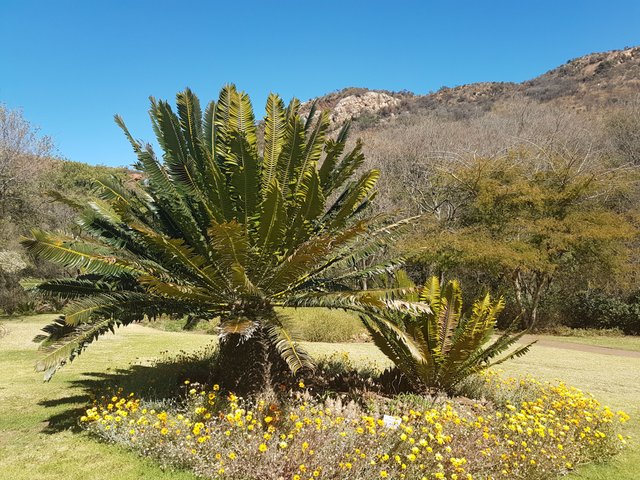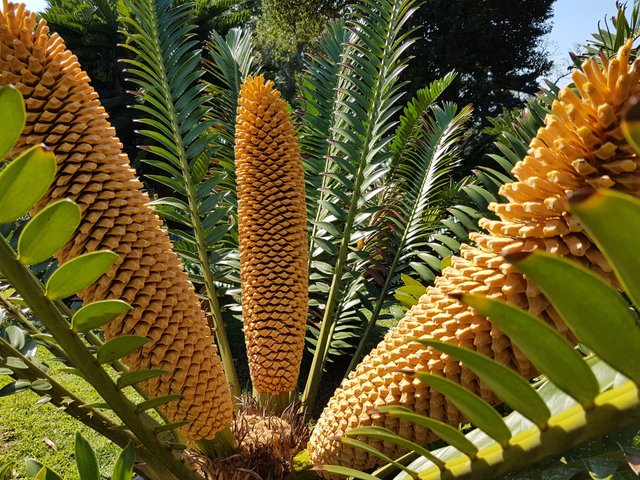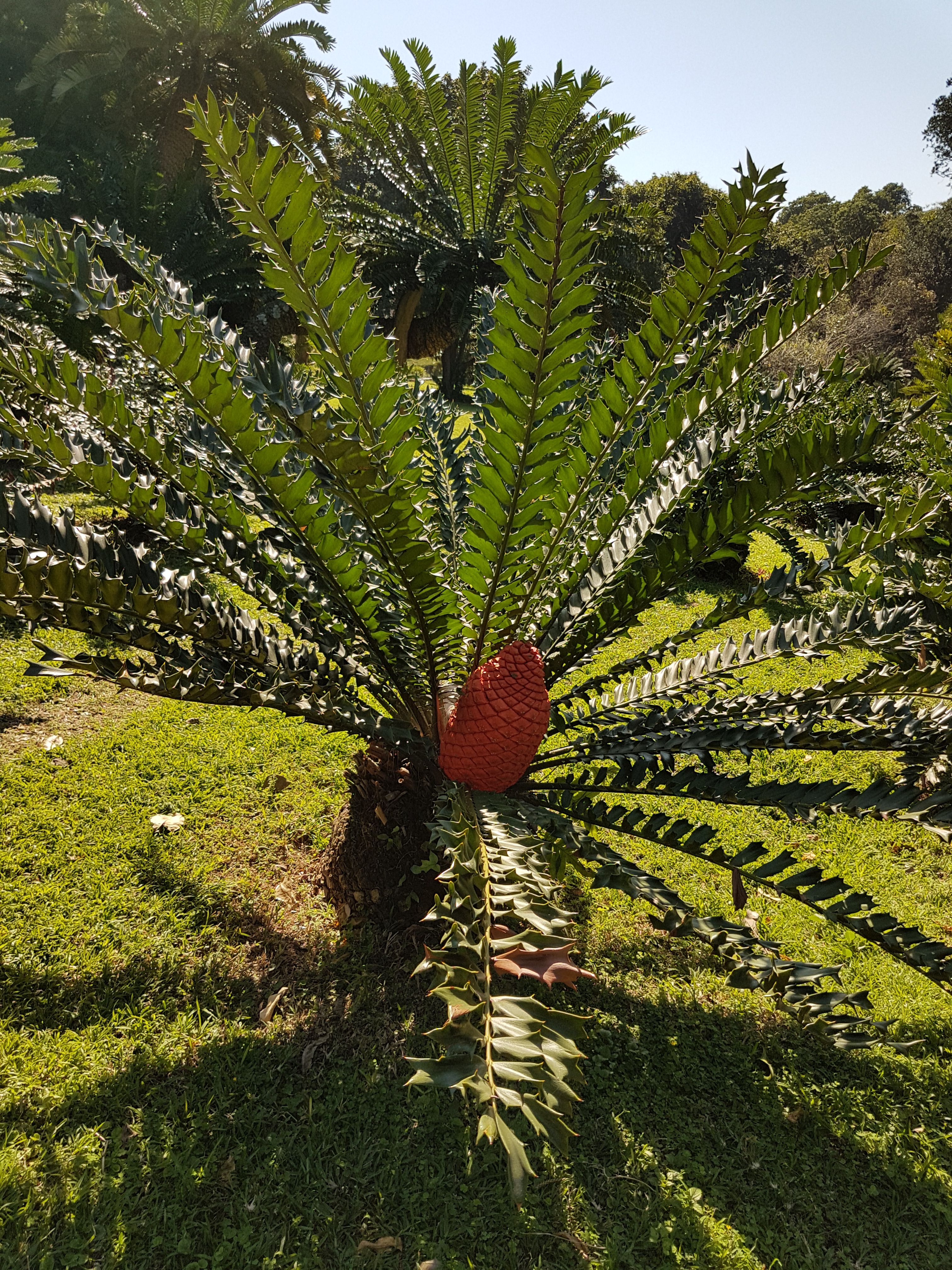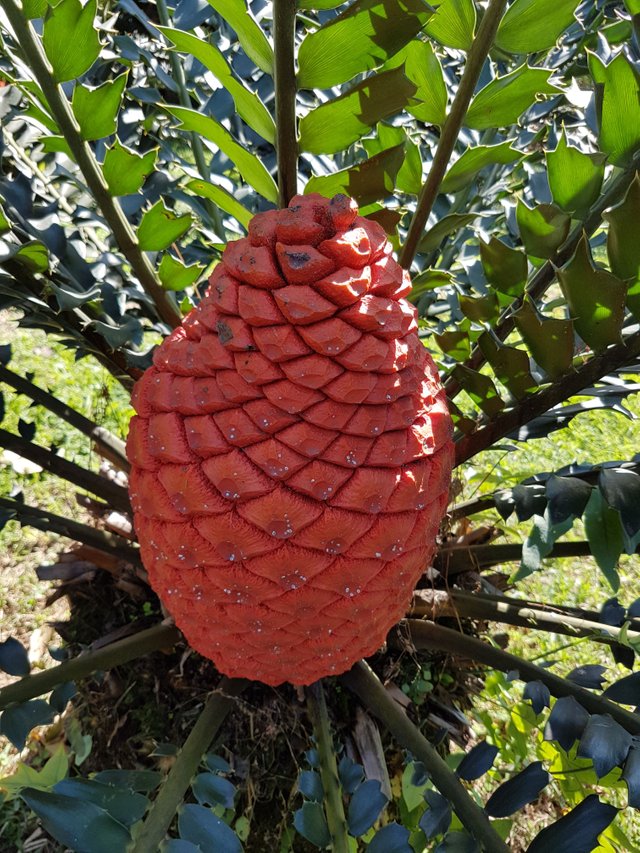The Cycad - Encephalartos - Living Fossil - broodboom (Afrikaans)

The Cycad thrived in prehistoric times, is a few million years old and can be found in fossil records all over the world. It was the main food source for herbivorous dinosaurs. It is one of the most threatened plant groups on Earth today.
At the San Diego Zoo, they have 108 species of which 78 is endangered. South Africa boasts with 38 cycad species and 68% of them are threatened with extinction. You need a permit to grow the indigenous Encephalartos cycad in your garden.

The name cycad stem from the Greek word ‘cyckos’ meaning palm-like. It is a Conifer/deciduous(needled evergreens - pines, firs and yews) and gymnosperms (naked seeds), their reproductive organs are in their cones and not flowers. The colour of the cone can be anything from green, yellow-green, yellow or salmon, depending on the species and age of the cone. The plant can be male (pollen bearing) or female (seed bearing).
It is a unique slow growing, long-living, lush and exotic looking plant that increases in value as they age and grow. The larger plants can take up to a decade to reach their full size which makes them expensive.

The Cycad is resilient with its tough outer cuticle that prevents moisture loss ideal for the warmer climates. They thrive in well-drained soil and plenty of sun.
Cycads are considered poisonous due to the highly toxic seed kernels in the cone. These toxins can cause liver damage, vomiting, diarrhoea, headaches, dizziness and seizures. The Cycad is edible though after the toxins have been removed carefully. It contains starch in the pith of the trunk which the "Hottentots" (South African Tribe) used as bread dough after fermenting it.
Encephalartos ferox

The Encephalartos Ferox is a popular cultivated cycad, growing close to the ocean - in Natal and Mozambique. It has 15cm long dark green, spine-tipped lobed leaves. They produce dark salmon cones which emerge in succession. The male cone is a 45cm long cylinder and the female cone is about 20-45cm and sessile. They thrive in warmer, humid conditions with well-drained soil.

The two species in my photos I discovered at the Durban Botanical Gardens, it was taken with my Samsung Galaxy S7.
Thank-you @crazymumzysa for your wonderful article on Cycad - Encephalartos. It is amazing how long it has been in existence. Hopefully they will recover to thrive again. Climate change and man made disasters help to push more things into extinction. I am glad that you shared this with us. Thank-you!
I hope you are doing well. I know school and raising a family can be very time consuming and difficult at times. My positive energy and thoughts are being sent to you. Please take care! :D
Hello, Cabbagepatch. Thank you very much for your energy it is needed. Enjoy a fabulous weekend!!
Did you know the cycads at Kirstenbosch botanical gardens have a sophisticated alarm system to prevent their theft! Cycads are so valuable to collectors that they are constantly stolen.
Wow.. Berarti itu sangat luar biasa.
Thank you for sharing this with us whistlejacket, I did not know but can believe it.
Thank you for the information .. this is good news .. hopefully many who ngevoted you .. follow me maybe we can be friends well
That's a good history. And i like her ..
And you have a great picture.
IAM STEEMIAN INDONESIAN
Very interesting))) Thank you for telling us about this plant!))) I did not even suspect that such plants are on the planet)))
Definitivamente tus fotografías son geniales, te felicito.
it looks a bit like pineapple. i wonder if that has gotten anybody in trouble.
As a group, all cycads are amazing plants. There are multiple reasons for the increasing popularity of cycads. First and foremost is that they are quite rare and different appearing. Some have unarmed, soft leaves. Others are quite armed and spiny. Some species are very erect with near 7 meter leaves while others have a low profile that is pendulous and floppy. There are even miniature species that are only about a foot tall. By the way i'm new here in steemit, please feel free to drop by my profile @asbonclz and see my posts, thanks and God bless!
The photos are amazing and some info about I didn't know!
In the USA there is one type commonly called the Sago Palm(it IS a cycad, not a palm). My buddy had an 8 ft one, but the wife wanted it gone because the fronds would poke and scratch you and it was near the driveway. He killed it and removed it.........
.....then he learned he could have sold it for at least $1000.....probably more!!